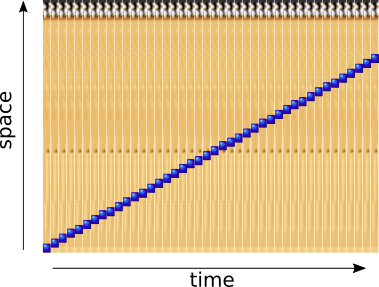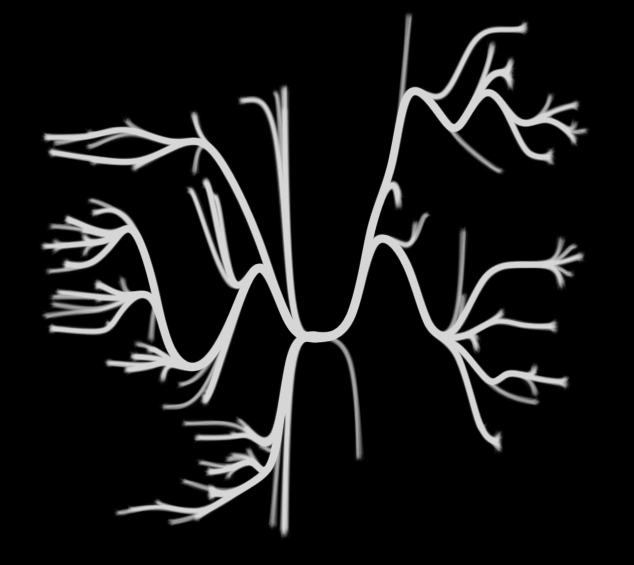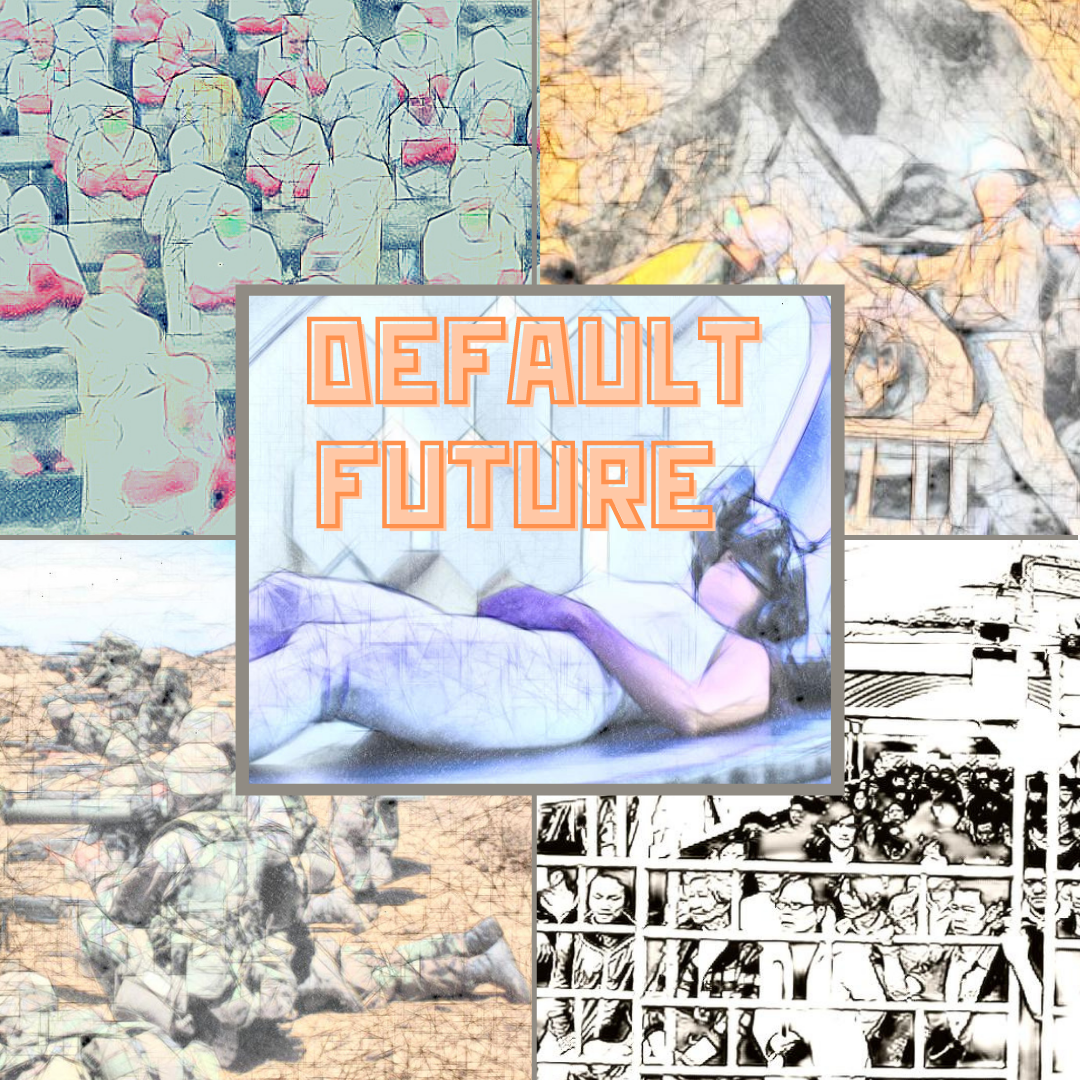Identifield: information in the material universe
Epistemic status: It should go without saying that I don't have any certainty about the fundamental nature of the universe. This is just a bit of conjecture that gets me through my day.
As I moved from physics to biology and now into machine learning, my worldview has shifted from one focused on material reality to one that deals largely with abstractions of information. I've thought a great deal about these two viewpoints and wondered about their relationship. Importantly, as I've interacted with people ensconced in these two fields, I've noticed a tangible difference between two distinctive mental models of the fundamental space that things occupy.
The material view focuses on conventional spacetime as the true space that existing entities occupy. Meanwhile, the information-centric view defines the space of ideas as the true space that existing entities occupy. To put a finer point on the distinction, I've assigned names based on pairs of philosophers and scientists who I think most closely represents each conception of reality
| Aristotelian/Feynmanian | Platonic/Einsteinian |
|---|---|
| A standard material universe | A space of purified ideas |
| Reality is physical | Reality is the ideals we uncover |
| There is no real space where ideas exist, they are just an artifact of our discourse | The particular details of the different manifestations of these ideals are largely unimportant |
| Our useful efforts lie in efficiently cataloging the physical by the discussion of observations of phenomena | Our useful efforts lie in properly mapping specific phenomena back into the space of ideals where their fundamental principles are truly defined |
So which is correct? I've thought a lot about the relation between our material universe and the idealistic universe, and as with every other ethical or epistemological dualism I've seen in my life, the answer may be just the most boring: both. It seems to me that the very thing that makes our universe an interesting one to inhabit is that the two spaces coexist and are intermingled. And perhaps, the very validity of our consciousness is predicated on the comingling of these two spaces.
To describe this third "necessary combination" view, I've had to develop what I believe to be a new description of the way that entities exist in this third space interpretation of the universe. I've called this new construct an identifield (pronounced identi-field), and I'd like to take the rest of this blog post to describe the idea.
What is an identifield?
Identifield is a shorthand term for an information identity spacetime field. It is a means for articulating how a thing of information (ie platonic ideal) exists in the material world (ie in physical reality). To look at an identifield is to look at how an idea fits into the evolution of all ideas spread across physical time and space. That sounds a little extravagant, but once it's broken down, I think it isn't totally crazy.
I'll first explain the concept by example, and then explain the terminology in detail.
Explained By Example
It might help to take a simple example where we are looking at the information contained in a single paragraph in a book. We would start by asking, "Does the information live just in the printed words of a single page?" No, at the very least it has to be present in all the printed copies of that book. But the information can be thought to exist in a whole lot of other places too.
Imagine that paragraph contains the quote "Call me Ishmael" from Moby Dick. That would mean some of the information lives in a small part of all the copies of Moby Dick as well. And suppose that when the author quoted that line in Moby Dick, she did so because she had also read an article that suggested quoting Moby Dick is a good strategy for getting published. So some seed of the generation of the paragraph was formed in that article too. All the places where the author gathered information to write that paragraph include some partial component of the information contained within it.
And that isn't the end of it either. It's also present in the minds of anyone who might read the paragraph and internalize that information. How much of the information is present will vary depending on how much attention the audience was paying, and whether they correctly translated the information into their own brains. Finally, the information in that paragraph may someday be referenced in another novel, which can lead to diffusion to a whole other set of people.
So if you were to try to imagine where that information lives at all times and how "strong" of a residue of the information is present, you'd have to picture a 4D spacetime field occupying all the places we just mentioned. That's an identifield.
Explained in greater detail
If the craziness above wasn't enough for you, here's a little more explanation. Lets break down the defintion of identifield, information identity spacetime field.
Information Identity
To start, I should explain what I mean by an information identity. I'm using the term to mean, literally, that identity which defines some information. Of course, to understand that we need to break down what I mean by information and identity.
Even though information is a fairly abstract concept, I think most people seem to have a pretty intuitive sense of what it is. To cut to the chase, let's just say information is a description of ideas that we can transmit around through physical manifestations. Note that information is not the physical manifestation itself. For example, If I hand you a piece of paper with the words, "Hi, my name is Will," typed on it, the piece of paper and ink is not the information, the words are the information. The words convey the idea that my name is Will, but this idea is not the information either. Keep in mind that words are not the only form of information. As another example, biological organisms contain DNA, which transmits the information of the individual's genetic code.
We can tackle identity in a similar way. I like to use a definition of identity that hybridizes the philosophical definition with our more intuitive understanding of personal identity. So for the sake of this discussion let's say that identity is the combination of all those aspects of a thing that make it that unique thing in and of itself. So your jacket's identity is all the things that make your jacket, your jacket and not somebody else's.
The information identity is then just the way of distinguishing a piece of information as unique to itself. It's important to remember that unlike the identity of a physical jacket, information is not the medium itself, but rather the meaning conveyed on the medium. This means that information can be replicated exactly, and so the information identity can be shared among many different conduits of information all over the world. As an example, take the information contained in one's genetic code. If we were to read that information by sequencing someone's genome and store the sequence of the genome in a computer. The information identity is that which makes the person's genetic sequence their own. Importantly, it is present in both the sequence in their physical DNA and in the sequence of bits stored in the computer that has read their genome.
Spacetime
To picture an information identity as it exists in the world, we'd need to mentally visualize the locations of all the copies of that information in the world. If we were imagining the information in a news article we would imagine all the open web browsers that are viewing that article and all the copies sitting on computer servers. Next, we'd further imagine the location in each person's mind where they are storing the information that they have just read. And if they communicate the story verbally, the information is contained in the waves of air particles propagating from their mouths.
All of this is overwhelming to picture in the moment because there are some people navigating to and from the page, reading, forgetting, and discussing, off and on all the time. For me, it helps to broaden our imagination of information existing in all points in space and take it one step further. We imagine not just where that information is at this instant, but where it has been at all points in time.
To imagine this, we turn to a concept from physics called spacetime. If you are unfamiliar with the idea of spacetime, I've written a short visual explainer to give some background. But for those who are familiar with the concept, you will recall that spacetime allows us to project a single physical object, like a bowling ball, simultaneously to all points in space that it will ever occupy. This turns compact objects into extruded ones such as the one in this illustration.

Here, a bowling ball starts at one end of the lane and is rolled to the other end. But extruded through time, it looks like a tube that connects from end to end. This is the same situation for the information identities described above. However, the information identity isn't relegated to a single tube like the bowling ball because the information identity may exist in many, far-reaching locations at once.
We can think about what happens when we start replicating information. For example, imagine my friend wants to come over and copy a flash drive. Well if you looked at some information identity housed on that flashdrive in spacetime, you'd see it would look like a single tube at early times (like the bowling ball) and then suddenly it would split to become two tubes that snake around independently.
This takes us a long way to seeing the full picture of information residing in the physical world. But there is still one problem: How do we deal with pieces of information that are very similar but slightly different. To begin, let's ask, what happens if something goes wrong when we copy the flash drive and some small difference appears. Are they two totally different information identities now? How do we deal with that?
Field
The final piece of the identifield is allowing the information identity to exist in a continuous state rather than as something fully binary. We want the "presence" of the information to vary continuously from 100% when you have an exact copy to 0% when you have something that is totally unrelated. To describe this we turn to another physics concept called a field.
We're mostly familiar with fields in physics like gravitational force fields and elecromagnetic fields. But any quantity that varies in space can be described as a field. We can talk about the temperature field to describe how temperature varies throughout a house (warmer by the sunny windows, colder in the basement). We can even talk about more abstract things like an "intelligence field" that quantifies how intelligent the entities in one region of space are. For an intelligence field, parts of the world occupied by humans have a high value, parts occupied by slugs have a lower value (presumably) and rocks would have even lower value.
We're interested in the information identity spacetime field, which we can define as how much of the information identity is present across different points in space and time. This accounts for minor corruptions in the information as well as intentional changes to the underlying information. Importantly, when your identifiable unit of information is first "formed," it is often constructed by some restructuring of multiple previously existing pieces of information. This means that going back prior to its formation, you would see partial remnants of the information identity in any preceding ideas that might have been important.
Taken together, these elements allow us to visualize like in the example below. For more information on the visualization see this post.

The continuous nature of the identifield allows us to get away from the necessity of drawing hard demarcating lines for where two similar ideas diverge. Although this notion is necessarily abstract, there already exist many ways to compute the similarity of two pieces of information. The identifield does not predicate a single metric that need be used for measurement of similarity, only that some measurement exists and that we may assume many small perturbations will continue to change the measurement in a continuous manner.[*]
Implications of the Identifield
The purpose of framing the identifield is to aid in thinking about how ideas exist in the real world. Once you begin to imagine information identities existing in 4D spacetime, it's hard not to start thinking of the whole world in terms of this construct. I think there are at least three significant application areas of the identifield that could help us see the world with slightly greater clarity.
Mapping between idea space and physical space
You could imagine that some things are compact in the space of ideas, but sprawling in physical space. At the same time, certain philosophies could cover wide swaths of idea space, but only exist within the mind of a single meditating monk. Including the identifield in our vocabulary allows us to more clearly see that distinction.
Redefining the Self
I believe the most interesting implication of the identifield is what it means for our dearest information identity, our self. In my mind, I now see myself as composite identifield, processing and transforming all sources of information that I have absorbed. This is a sizable idea to unpack so I have elaborated in this post.
Intuiting meaning for the universe
I am currently writing at length about my interpretation of a meaning for the universe. The key takeaway (argued elsewhere) is that if (1) you are concerned with the outcomes of your actions and (2) remain unsure how specifically to act, it can be deduced that (3) you should assume that the universe falls into the class of universes with a purpose that can be discovered by intuition. The argument is long and complex so I encourage reading my reasons articles if you are curious.
Unfortunately, I do not have a way to prove which of my intuitions is correct. However, I've personally found it useful to use the mind-broadening effects of contemplating things as identifields to hone my intuition on the relation between my immediate action and the space of outcomes in the universe. This is only an intuitive connection, but it's one that personally holds meaning for me so I thought I should include it in this list of implications.
Conclusion
Unfortunately, there is no concrete conclusion offered by this framework. In fact, the identifield construct posits specifically that so long as you are thinking about even part of this idea, the idea does not conclude at all.
My website is my attempt to catalog the identifield of all the (useful) information that passes through Will Stedden. This particular identifield, is what I've called the bonkerfield (an identifield that is perhaps a little bit bonkers). If you take the information identity on this site with you and it informs your life, then you become a part of its identifield. And bonkerfield becomes a part of you.
...and if you share your thoughts with others in the comments, then well, it makes it much easier to watch the identifield forming :)
A note on continuity and sizes
All of this assumes that there is some granularity of space and time over which we will define a piece of information as coherent and allow changes between two discrete states to blur. For example, if you delete a few words in a paragraph and rewrite them, the identifield of the paragraph in that interim should not be meaningfully modified.
A careful observer may try to punch a hole in the physicality of the identifield by noting that physical fields are normally defined at arbitrarily small units of space. They will point out that to define a space as containing information you need to create some envelope with a macroscopic spatial scale. I agree that is necessary. However, that is not a problem as it should be noted that temperature and many other quantities that are commonly considered fields do not actually exist on an infinitesimal scale.
 will stedden
will stedden

